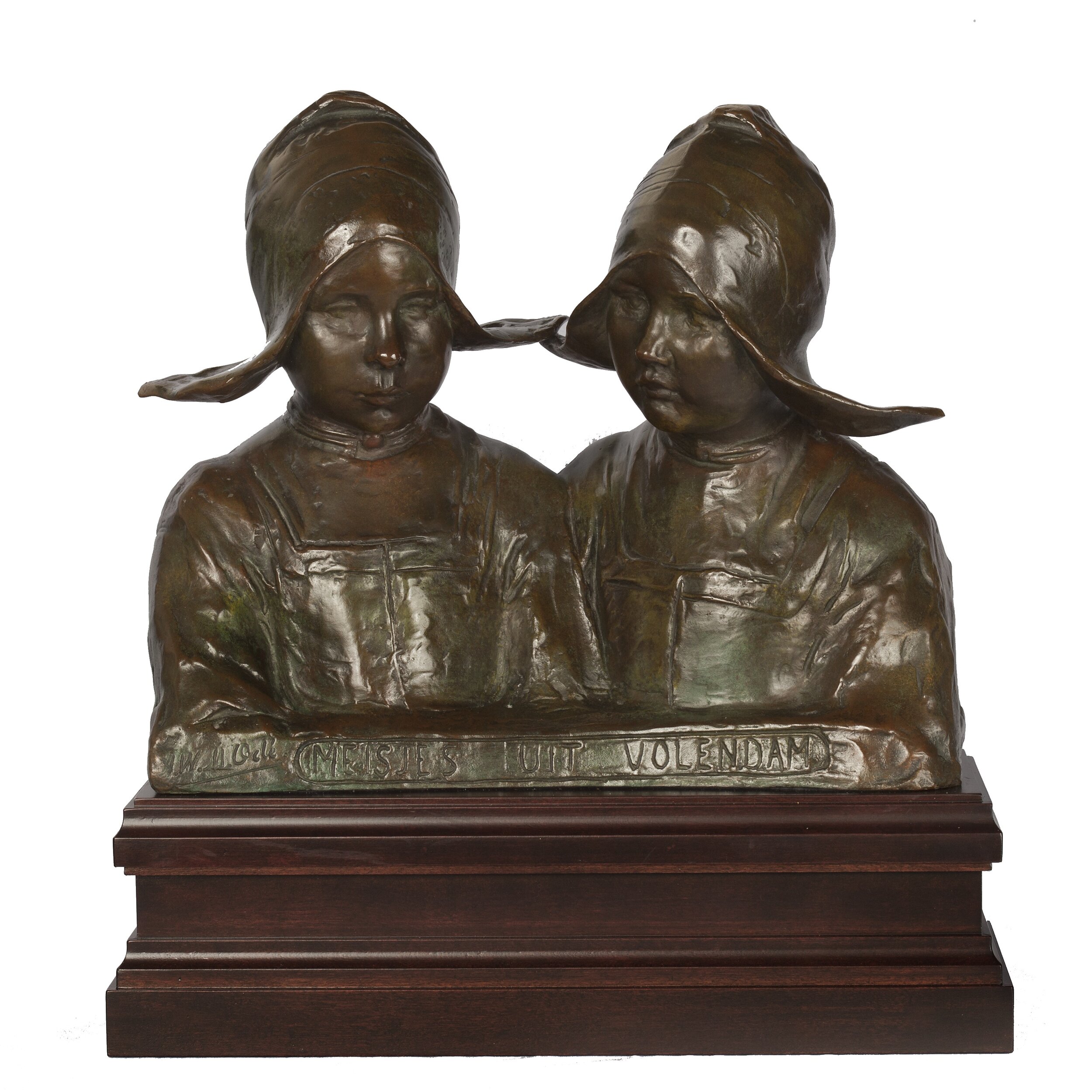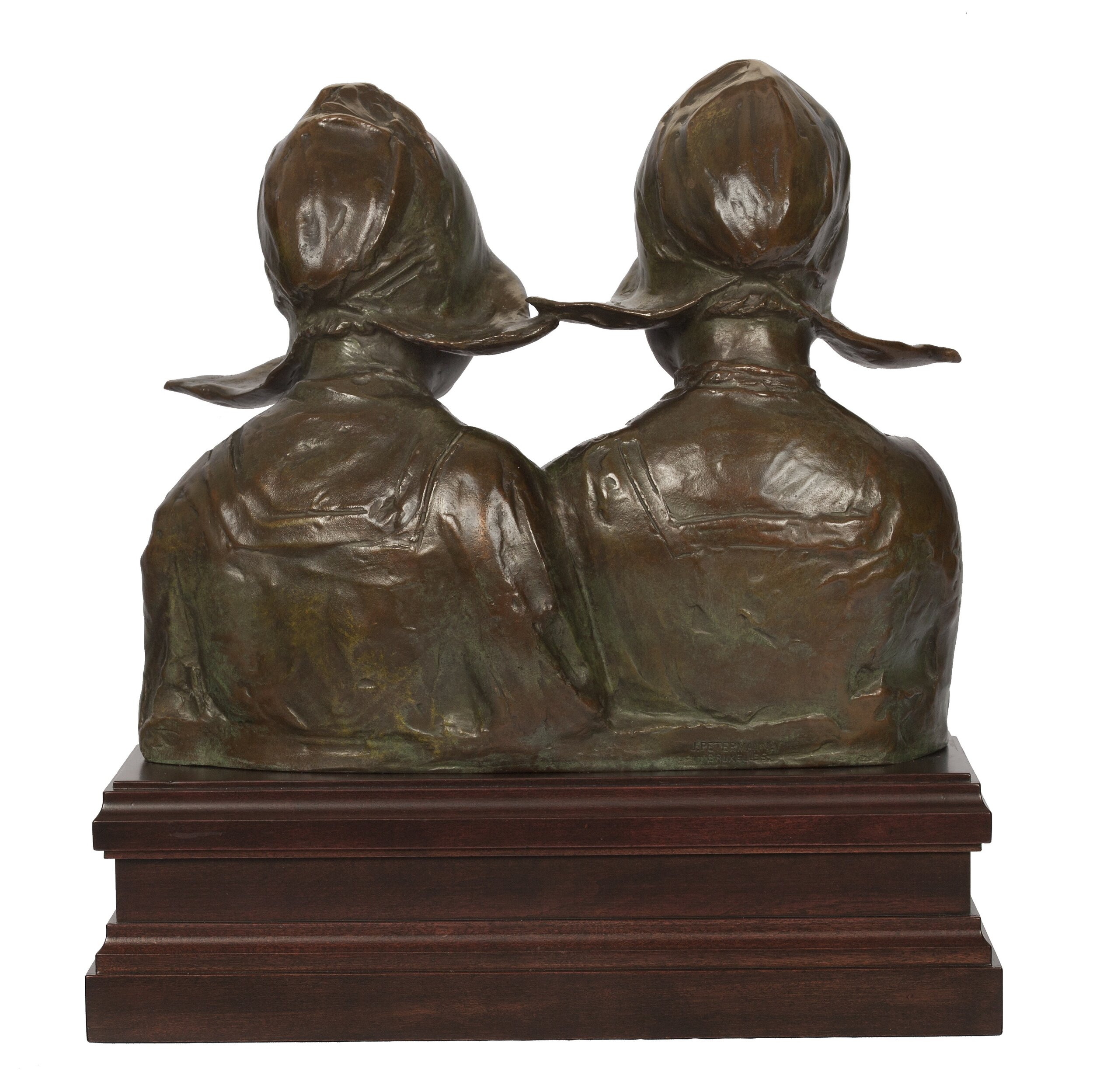

AREND WILLEM MAURITS ODÉ (Kethel en Spaland 1865 – Zuidlaren 1955)
Meisjes uit Volendam (Girls from Volendam)
signed A.W.M. Odé, inscribed with title Meisjes uit Volendam, and stamped J. Petermann Bruxelles
bronze, green-brown patina
height 9 ½ inches (24 cm), width 10 inches (25.5 cm)
PROVENANCE
Private Collection, Volendam
RELATED LITERATURE
Brian Dudley Barrett, Volendam Artists Village: The Heritage of Hotel Spaander, uitgeverij d'jonge Hond, Zuiderzeemuseum, 2009, p. 147
Volendam was famous for the attractiveness of its inhabitants[1] and this, combined with the population’s adherence to a traditional lifestyle and dress, drew artists from all over the world. From the 1880s onwards, spurred by the popularity of the Hague School’s imagery, artists scoured locations throughout the Netherlands in search of the “true” Holland. Volendam, eleven miles north of Amsterdam, was a remote fishing village accessible only by canal boat or carriage. Such isolation had left it largely untouched by the modernization as well as the industrialization prevalent in such cities as Rotterdam and Amsterdam and it was exactly this feature which proved so attractive.[2] Further, Volendamers were viewed as pious, honest, healthy and happy and their children particularly idealized.[3] Florence Craig Albrecht writing for Scribner’s Magazine in 1907 expressed the sentiment beautifully – “a group of tiny maidens in a stiff breeze on the dike resembles nothing more than a swarm of butterflies.”[4] Or Alice and Charles Williamson in The Botor Chaperon of 1908, “I can’t imagine anything more becoming than the transparent white caps that fold back and flare out over the ears like a soaring bird’s wings. Perhaps it was partly the effect of the light, but the young girls in their straight dark bodices, with flowered handkerchief-chemisettes, full blue skirts – pierced with pale-tinted stuff from waist to hips – and those flying, winged caps, looked angelic. They walked with their arms round each other’s waists.”[5]
Meisjes uit Volendam executed around 1900 features two young girls with round cherubic faces and bright eyes crowned by the distinctive lace wing caps of the village. Even as toddlers, girls were dressed as exact replicas of their mothers which included wearing the lace cap known as the Volendam “Hul”. Other traditional garb, as exemplified by our sitters, are what would have been black jackets enlivened by square yokes of a lighter color and material - the standard dress for all Volendam women. Also typical are their coral necklaces with a silver or gold clasp worn in the front. Although the children of Volendam were literally depicted hundreds of times in oil, watercolor, pastel, pencil and print sculpted likenesses from this period are exceedingly rare, particularly in duplicate. Another version of this cast was reproduced in the Zuiderzeemuseum’s exhibition catalogue of 2009, Volendam Artists Village: The Heritage of the Hotel Spaander (op. cit., p. 147).
Arend Willem Maurits Odé was a sculptor who specialized in portraits often featuring children, monuments and reliefs. He attended the art academies of Rotterdam and The Hague, completing his studies at the Académie des Beaux Arts, Brussels. He began his career in Schiedam and remained there until 1889 when he moved to The Hague. From 1898 – 1900 he taught at the Academy of Art in The Hague, followed by a professorship at the Technische Hogeschool in Delft until 1935. Afterwards he moved to Bilthoven until 1952, then Groningen up to 1954 and finally Zuidlaren.[6]
Odé was a member of “Arti et Amicitae,” Pulchri Studio and the Dutch Association of Sculptors. He participated in contemporary art exhibitions in Rotterdam, 1888; Arnhem, 1890 and 1897; and The Hague, 1890 and 1893. His teachings proved influential and he had a large number of students including Johan Coenraad Altorf, Hendricus Johannes Etienne and Piet Cornelis Kramer. He received notoriety for his contributions to the decoration of the façades of the Peace Palace in The Hague and the Rotterdam City Hall. One of his most engaging monumental sculptures, also cast by J. Petermann, Brussels, depicts Constantijn Huygens located at the entrance of the Scheveningen Woods at Ary van der Spuyweg. Other sculptures by Odé are in the Rijksmuseum, Amsterdam as well as the Gemeentemuseum and Nederlandse Postmuseum both in The Hague.[7]
[1] Celia B. Seymour, “At Volendam”, Pratt Institute Monthly, Pratt Institute, volume V, Brooklyn, N.Y., October 1896 – June 1987, p. 240; Florence Craig Albrecht, “Volendam, The Artist’s Village” in Scribner’s Magazine, volume 41, Charles Scribner’s Sons, New York, 1907, p. 334; and Alice Muriel Williamson & Charles Norris Williamson, The Botor Chaperon, Methuen & Co., London, 1908, p. 205.
[2] Ivo Blom “Of Artists and Tourists: Locating Holland in Two Early German Films” in A Second Life German Cinema’s First Decades, Amsterdam University Press, 1996, pp. 247 – 248, 254; and Annette Stott, Holland Mania, The Overlook Press, Woodstock, New York, 1998, pp. 44 – 45.
[3] Annette Stott, op. cit., p. 48; and Brian Dudley Barrett, op. cit., p. 248.
[4] Florence Craig Albrecht, op. cit., p. 334.
[5] Alice Muriel Williamson & Charles Norris Williamson, op. cit., p. 244.
[6] Pieter A. Scheen, “Arend Willem Maurits Odé” in Lexicon Nederlandse Beeldende Kunstenaars 1750 – 1880, Uitgeverij Pieter A. Scheen BV, ’s – Gravenhage, 1981, pp. 378 – 379.
[7] Ibid.